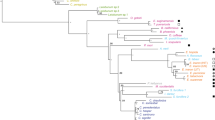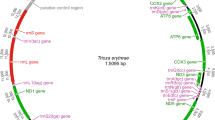Abstract
Anamorphic Beauveria are cosmopolitan entomopathogenic fungi that parasitize a broad range of insect species in virtually all terrestrial habitats. A diversity survey of 189 exemplar strains of Beauveria from the RCEF culture collection, representative of its taxonomic diversity, geographic distribution and insect host range in China, was conducted based on a combination of DGGE genotyping and nucleotide sequence analysis of the Bloc nuclear intergenic region. The DGGE assays detected 42 electrophoretically distinct haplotypes, with each haplogroup including 1–13 individuals. Nucleotide sequence analysis established that all haplogroups were uniquely distinguished by one or more nucleotide differences and that isolates from the same DGGE haplogroup share sequence identity. A phylogenetic analysis inclusive of this Bloc haplotype diversity assigned the Chinese Beauveria strains to six species lineages corresponding to B. bassiana sensu lato. (Bals.) Vuill, B. brongniartii (Sacc.) Petch, B. australis S.A. Rehner & Humber, B. asiatica S.A. Rehner & Humber, B. pseudobassiana S.A. Rehner & Humber and B. caledonica Bissett & Widden. B. australis is reported for the first time in China. This study represents the first phylogenetic survey of Beauveria species diversity in China, and demonstrates a simple and effective screening strategy to facilitate the identification of Beauveria genotypes.



Similar content being viewed by others
References
Bissett J, Widden P (1988) A new species of Beauveria from Scottish moorland soil. Can J Botany 66:361–362. doi:10.1139/b88-057
Charnley AK (1991) Microbial pathogens and insect pest control. Lett Appl Microbiol 12:149–157. doi:10.1111/j.1472-765X.1991.tb00528.x
Felsenstein J (1985) Confidence limits on phylogenies: an approach using the bootstrap. Evolution 39:783–791. doi:10.2307/2408678
Fischer SG, Lerman LS (1983) DNA fragments differing by single base-pair substitutions are separated in denaturing gradient gels: correspondence with melting theory. Proc Natl Acad Sci USA 80:1579–1583. doi:10.1073/pnas.80.6.1579
Fodde R, Losekoot M (1994) Mutation detection by denaturing gradient gel electrophoresis (DGGE). Hum Mutat 3:83–94. doi:10.1002/humu.1380030202
Garrido-Jurado I, Márquez M, Ortiz-Urquiza A, Santiago-Álvarez C, Iturriaga E, Quesada-Moraga E, Monte E, Hermosa R (2011) Genetic analyses place most Spanish isolates of Beauveria bassiana in a molecular group with word-wide distribution. BMC Microbiol 11:84. doi:10.1186/1471-2180-11-84
Huang B, Li CR, Ding DG, Fan MZ, Li ZZ (1997) A new record of Beauveria in China. Mycosystema 16:317 (in Chinese)
Huang B, Li CR, Li ZZ, Fan MZ, Li ZZ (2002) Molecular identification of the teleomorph of Beauveria bassiana. Mycotaxon 81:229–236
Huang B, Chen MJ, Wang SB, Li ZZ, Fan MZ (2007) A new record of Beauveria isolated from Scolytidae in China. Mycosystema 26:139–142 (in Chinese)
MacLeod DM (1954) Investigation on the genera Beauveria Vuill. and Tritirachium Limber. Can J Botany 32:818–890. doi:10.1139/b54-070
Manzano M, Cocolin L, Longo B, Comi G (2004) PCR-DGGE differentiation of strains of Saccharomyces sensu stricto. Anton Leeuw Int J G 85:23–27. doi:10.1023/b:anto.0000020270.44019.39
Meyling NV, Lubeck M, Buckley EP, Eilenberg J, Rehner SA (2009) Community composition, host range and genetic structure of the fungal entomopathogen Beauveria in adjoining agricultural and seminatural habitats. Mol Ecol 18:1282–1293. doi:10.1111/j.1365-294X.2009.04095.x
Meyling NV, Pilz C, Keller S, Widmer F, Enkerli J (2012) Diversity of Beauveria spp. isolates from pollen beetles Meligethes aeneus in Switzerland. J Invertebr Pathol 109:76–82. doi:10.1016/j.jip.2011.10.001
Pu ZL, Li ZZ (1996) Insect mycology. Anhui Publishing House of Science & Technology, Hefei (in Chinese)
Pu SC, Chen MJ, Ma ZY, Xie L, Li ZZ, Huang B (2010) Genotyping isolates of the entomopathogenic fungus Beauveria bassiana sensu lato by multi-locus polymerase chain reaction-denaturing gradient gel electrophoresis (PCR-DGGE) analysis. Afr J Biotechnol 9:4290–4294
Rehner SA, Buckley E (2005) A Beauveria phylogeny inferred from nuclear ITS and EF1-a sequences: evidence for cryptic diversification and links to Cordyceps teleomorphs. Mycologia 97:84–98. doi:10.3852/mycologia.97.1.84
Rehner SA, Posada F, Buckley EP, Infante F, Castillo A, Vega FE (2006) Phylogenetic origins of African and neotropical Beauveria bassiana s.l. pathogens of the coffee berry borer, Hypothenemus hampei. J Invertebr Pathol 93:11–21. doi:10.1016/j.jip.2006.04.005
Rehner SA, Minnis AM, Sung GH, Luangsa-ard JJ, Devotto L, Humber RA (2011) Phylogeny and systematics of the anamorphic, entomopathogenic genus Beauveria. Mycologia 103:1055–1073. doi:10.3852/10-302
Ronquist F, Huelsenbeck JP (2003) MrBayes 3: Bayesian phylogenetic inference under mixed models. Bioinformatics 19:1572–1574. doi:10.1093/bioinformatics/btg180
Sheffield VC, Cox DR, Lerman LS, Myers RM (1989) Attachment of a 40-base-pair G+C-rich sequence (GC-clamp) to genomic DNA fragments by the polymerase chain reaction results in improved detection of single-base changes. Proc Natl Acad Sci USA 86:232–236. doi:10.1073/pnas.86.1.232
Swofford DL (2003) PAUP*. Phylogenetic analysis using parsimony (*and other methods), version 4b10. Sinauer Associates, Sunderland
Thompson JD, Gibson TJ, Plewniak F, Jeanmougin F, Higgins DG (1997) The CLUSTAL_X windows interface: flexible strategies for multiple sequence alignment aided by quality analysis tools. Nucl Acids Res 25:4876–4882. doi:10.1093/nar/25.24.4876
Vuillemin P (1912) Beauveria, nouveau genre de Verticilliacies. Paris Soc Botan Franc Bull 59:34–40 (in French)
Zhu H, Qu F, Zhu LH (1994) Isolation of genomic DNAs from fungi using benzyl chloride. Mycosystema 13:34–40 (in Chinese with English summary)
Acknowledgments
We are grateful to Drs. Mingjun Chen and Shengli Zhang for their kind help with the collection and isolation of Beauveria samples. This work was supported by a grant from the Natural Science Foundation of China (nos. 31070009 and 30300004).
Author information
Authors and Affiliations
Corresponding authors
Electronic supplementary material
Below is the link to the electronic supplementary material.
Rights and permissions
About this article
Cite this article
Cai, Y., Pu, S., Nie, Y. et al. Discrimination of Chinese Beauveria strains by DGGE genotyping and taxonomic identification by sequence analysis of the Bloc nuclear intergenic region. Appl Entomol Zool 48, 255–263 (2013). https://doi.org/10.1007/s13355-013-0179-1
Received:
Accepted:
Published:
Issue Date:
DOI: https://doi.org/10.1007/s13355-013-0179-1




